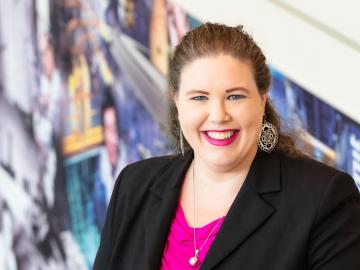Filter News
Area of Research
- (-) Materials (69)
- (-) Neutron Science (46)
- Advanced Manufacturing (2)
- Biology and Environment (21)
- Clean Energy (55)
- Computational Engineering (1)
- Computer Science (2)
- Fusion and Fission (3)
- Isotopes (2)
- Materials Characterization (2)
- Materials for Computing (9)
- Materials Under Extremes (1)
- National Security (13)
- Nuclear Science and Technology (3)
- Quantum information Science (1)
- Supercomputing (53)
News Topics
- (-) Big Data (1)
- (-) Computer Science (11)
- (-) Frontier (3)
- (-) Grid (2)
- (-) Materials (40)
- (-) Molten Salt (2)
- (-) Neutron Science (42)
- (-) Physics (16)
- (-) Polymers (6)
- (-) Sustainable Energy (8)
- 3-D Printing/Advanced Manufacturing (15)
- Advanced Reactors (1)
- Artificial Intelligence (4)
- Bioenergy (9)
- Biology (8)
- Biomedical (7)
- Biotechnology (1)
- Buildings (2)
- Chemical Sciences (20)
- Climate Change (5)
- Composites (3)
- Coronavirus (7)
- Critical Materials (8)
- Cybersecurity (4)
- Decarbonization (5)
- Energy Storage (20)
- Environment (10)
- Exascale Computing (1)
- Fusion (3)
- High-Performance Computing (3)
- Isotopes (5)
- ITER (1)
- Machine Learning (2)
- Materials Science (39)
- Microscopy (12)
- Nanotechnology (22)
- National Security (3)
- Net Zero (1)
- Nuclear Energy (3)
- Partnerships (8)
- Quantum Computing (1)
- Quantum Science (11)
- Renewable Energy (1)
- Security (2)
- Space Exploration (1)
- Summit (4)
- Transformational Challenge Reactor (1)
- Transportation (6)
Media Contacts

After a highly lauded research campaign that successfully redesigned a hepatitis C drug into one of the leading drug treatments for COVID-19, scientists at ORNL are now turning their drug design approach toward cancer.

The Spallation Neutron Source at the Department of Energy's Oak Ridge National Laboratory set a world record when its particle accelerator beam operating power reached 1.7 megawatts, substantially improving on the facility’s original design capability.

Scientist-inventors from ORNL will present seven new technologies during the Technology Innovation Showcase on Friday, July 14, from 8 a.m.–4 p.m. at the Joint Institute for Computational Sciences on ORNL’s campus.

Like most scientists, Chengping Chai is not content with the surface of things: He wants to probe beyond to learn what’s really going on. But in his case, he is literally building a map of the world beneath, using seismic and acoustic data that reveal when and where the earth moves.

Scientists at ORNL have invented a coating that could dramatically reduce friction in common load-bearing systems with moving parts, from vehicle drive trains to wind

Stan David, retired scientist and Corporate Fellow Emeritus at the Department of Energy’s Oak Ridge National Laboratory, was awarded the Joining and Welding Science Award from the Joining and Welding Research Institute at Osaka University, Japan.

Rigoberto Advincula, a renowned scientist at ORNL and professor of Chemical and Biomolecular Engineering at the University of Tennessee, has won the Netzsch North American Thermal Analysis Society Fellows Award for 2023.

Led by Kelly Chipps of ORNL, scientists working in the lab have produced a signature nuclear reaction that occurs on the surface of a neutron star gobbling mass from a companion star. Their achievement improves understanding of stellar processes generating diverse nuclear isotopes.

Kelly Chipps, a nuclear astrophysicist at ORNL, has been appointed to the Nuclear Science Advisory Committee, or NSAC. The committee provides official advice to DOE and the National Science Foundation, or NSF, about issues relating to the national program for basic nuclear science research.

Anne Campbell, an R&D associate at ORNL, has been selected for an Emerging Professional award from ASTM International. ASTM, formerly the American Society for Testing and Materials, is an international standards organization that develops and publishes voluntary consensus technical standards for a wide range of materials, products, systems and services.

